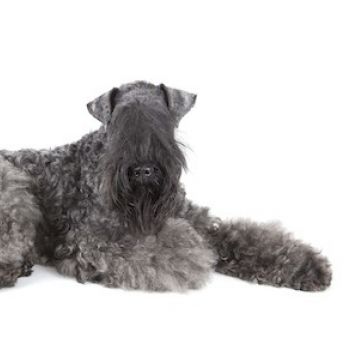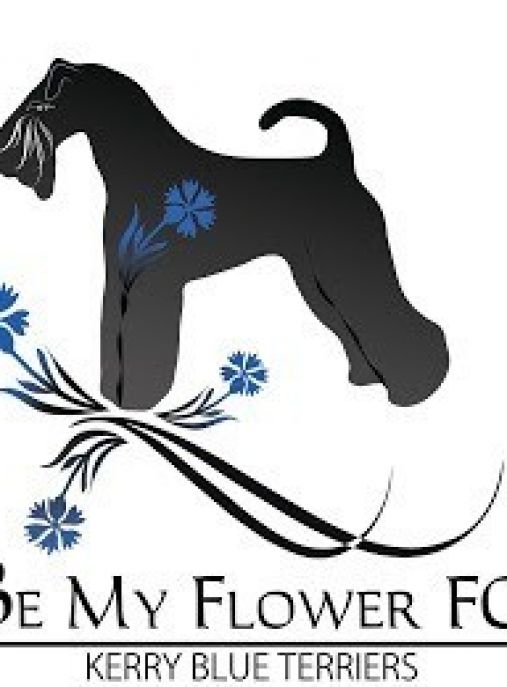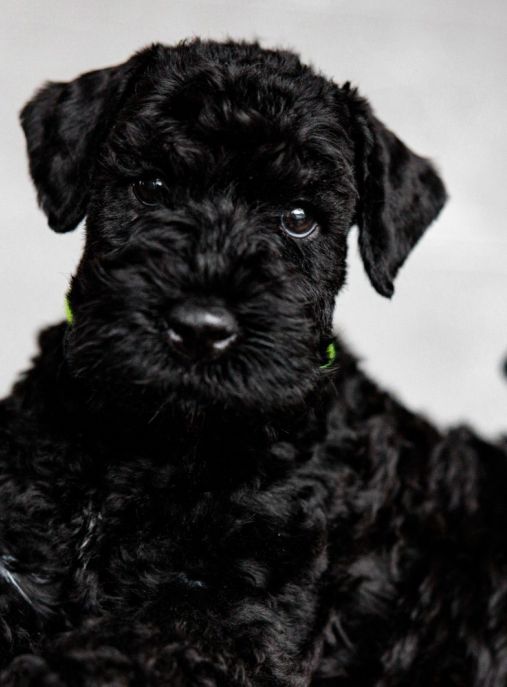The Kerry Blue Terrier is a distinctive and versatile dog breed known for its striking appearance and spirited personality. With a unique coat and a rich history, this breed has captured the hearts of dog enthusiasts worldwide. In this text, we will delve into the fascinating world of the Kerry Blue Terrier, exploring its history, characteristics, and interesting facts.
The Kerry Blue Terrier, also known as the Irish Blue Terrier, is a medium-sized dog breed that hails from County Kerry, Ireland. It is instantly recognizable by its dense, wavy, and soft blue-gray coat, which gives it a regal and elegant appearance. The coat of a Kerry Blue Terrier is non-shedding and requires regular grooming to maintain its lustrous appearance.
The history of the Kerry Blue Terrier dates back several centuries. It is believed that the breed's ancestors were brought to Ireland by Spanish Armada shipwrecks in the 16th century. Over time, these dogs were crossbred with local terriers, resulting in the development of the Kerry Blue Terrier we know today. Initially, they were primarily used as working dogs for hunting small game, herding livestock, and guarding property.
According to the Fédération Cynologique Internationale (FCI) typology, the Kerry Blue Terrier belongs to Group 3: Terriers. This group comprises various terrier breeds that share common traits such as courage, tenacity, and a strong prey drive. Within this group, the Kerry Blue Terrier is classified under Section 1: Large and Medium-sized Terriers.
Kerry Blue Terriers are known for their intelligence, loyalty, and playful nature. They are highly adaptable and can thrive in various environments, making them suitable for both urban and rural settings. These dogs form strong bonds with their families and are known to be excellent companions and watchdogs. However, they can be reserved with strangers and may require proper socialization from an early age.
In terms of physical characteristics, the Kerry Blue Terrier typically stands between 17 and 19 inches (43-48 cm) at the shoulder and weighs between 33 and 40 pounds (15-18 kg). They have a sturdy and well-muscled build, allowing them to excel in various activities such as agility, obedience, and tracking. Their expressive eyes, which are usually dark in color, are a prominent feature that adds to their charm.
The average life expectancy of a Kerry Blue Terrier is around 12 to 15 years, which is relatively long for a medium-sized dog breed. However, like all breeds, they may be prone to certain health issues, including hip dysplasia, progressive retinal atrophy (PRA), and hypothyroidism. Regular veterinary check-ups, a balanced diet, and sufficient exercise are essential for maintaining their overall health and well-being.
One interesting fact about Kerry Blue Terriers is that their coat color changes as they mature. Puppies are born with a black coat, which gradually transitions to the iconic blue-gray color as they grow older. Additionally, their coat requires hand-stripping, a grooming technique that involves removing dead hair by hand, to maintain its texture and appearance.
In conclusion, the Kerry Blue Terrier is a captivating breed with a rich history and unique characteristics. From its origins in Ireland to its versatile nature and striking appearance, this breed has captured the hearts of many dog lovers. Whether as a loyal companion, a working dog, or a show dog, the Kerry Blue Terrier continues to leave a lasting impression with its intelligence, loyalty, and distinctive blue-gray coat.
The Kerry Blue Terrier is a breed of dog known for its unique appearance and charming personality. With a distinctive coat of soft, wavy hair that ranges from silver-blue to deep slate, these dogs are truly eye-catching. However, their character goes far beyond their striking looks. Kerry Blue Terriers are intelligent, loyal, and full of energy, making them a wonderful companion for the right owner.
One of the most notable traits of Kerry Blue Terriers is their friendly and affectionate nature. They are known to be excellent family dogs, forming strong bonds with their owners and being particularly gentle with children. Their sociable disposition also extends to other animals, making them a great choice for households with multiple pets. However, it is important to note that early socialization is crucial to ensure they develop good manners and get along well with others.
Despite their friendly nature, Kerry Blue Terriers are also known for their independent streak. They possess a strong sense of self and can be quite stubborn at times. This means that training them requires patience, consistency, and positive reinforcement. Harsh training methods or punishment can lead to resistance and even aggression. Instead, using rewards, treats, and praise will yield much better results.
Kerry Blue Terriers are highly intelligent dogs, which can be both a blessing and a challenge. On one hand, their intelligence makes them quick learners and eager to please their owners. On the other hand, it means they need mental stimulation to prevent boredom and destructive behavior. Engaging them in activities such as puzzle toys, obedience training, and interactive play sessions will keep their minds sharp and prevent them from becoming restless.
Exercise is another important aspect of raising a Kerry Blue Terrier. These dogs have a moderate to high energy level and require daily physical activity to stay happy and healthy. Regular walks, runs, or playtime in a securely fenced yard are essential to meet their exercise needs. Without proper exercise, they may become bored and resort to destructive behaviors like excessive barking or chewing.
Grooming a Kerry Blue Terrier is a commitment that requires regular attention. Their unique coat is non-shedding, which means it requires regular brushing to prevent matting and tangling. Many owners opt to have their Kerry Blue Terrier professionally groomed every few months to maintain their coat's appearance and health. Additionally, regular ear cleaning, teeth brushing, and nail trimming are necessary to keep them in top condition.
In summary, Kerry Blue Terriers are intelligent, loyal, and friendly dogs that make excellent companions for the right owner. They thrive in a loving and active environment where they receive proper training, mental stimulation, and exercise. With the right care and attention, a Kerry Blue Terrier can bring joy and companionship to their family for many years to come.
The Kerry Blue Terrier is a beautiful and intelligent breed known for its unique blue-gray coat and playful personality. To ensure the health and happiness of your Kerry Blue Terrier, it is important to provide them with proper care and attention. Here are some tips on how to care for dogs of this breed, including what to do and what not to do:
1. Grooming: The Kerry Blue Terrier's coat requires regular grooming to keep it looking its best. Brush their coat at least once a week to prevent matting and remove loose hair. Regularly trim their hair around the eyes, ears, and paws to maintain cleanliness. Professional grooming every 6-8 weeks is recommended to maintain the breed's signature appearance.
2. Exercise: Kerry Blue Terriers are an active breed that requires daily exercise to keep them physically and mentally stimulated. Take them for daily walks, engage in play sessions, and provide them with toys that challenge their intelligence. Regular exercise will help prevent behavioral issues and keep them in good shape.
3. Training: Kerry Blue Terriers are highly intelligent and respond well to positive reinforcement training methods. Start training them from a young age to establish good behavior and obedience. Socialize them with other dogs and people to prevent aggression or shyness. Consistency, patience, and rewards-based training will yield the best results.
4. Diet: Provide your Kerry Blue Terrier with a balanced and nutritious diet to maintain their overall health. Feed them high-quality dog food that is appropriate for their age, size, and activity level. Avoid overfeeding to prevent obesity, as this breed is prone to weight gain. Consult with your veterinarian for specific dietary recommendations.
5. Health Care: Regular veterinary check-ups are essential to ensure your Kerry Blue Terrier's well-being. Vaccinations, parasite prevention, and dental care should be part of their routine healthcare. Additionally, be aware of breed-specific health issues such as hip dysplasia, cataracts, and allergies. Early detection and treatment can help manage these conditions effectively.
6. Mental Stimulation: Kerry Blue Terriers are intelligent dogs that thrive on mental stimulation. Engage them in activities that challenge their problem-solving skills, such as puzzle toys or obedience training. Mental stimulation helps prevent boredom and destructive behavior.
7. Socialization: Expose your Kerry Blue Terrier to various environments, people, and animals from a young age. Proper socialization will help them become well-rounded and confident dogs. Encourage positive interactions with other dogs and people to prevent fear or aggression issues.
What not to do:
1. Neglect grooming: Neglecting regular grooming can lead to matting, skin issues, and discomfort for your Kerry Blue Terrier. Avoid this by establishing a grooming routine and sticking to it.
2. Use harsh training methods: Kerry Blue Terriers respond best to positive reinforcement training techniques. Avoid using harsh or punitive methods, as it can damage their trust and lead to behavioral problems.
3. Overfeed: Overfeeding can lead to obesity, which can have detrimental effects on your dog's health. Follow feeding guidelines and consult with your veterinarian to determine the appropriate portion sizes for your Kerry Blue Terrier.
4. Isolate: Kerry Blue Terriers are social dogs that thrive on human companionship. Avoid leaving them alone for extended periods as it can lead to separation anxiety and destructive behavior. Provide them with plenty of attention and interaction.
5. Skip regular veterinary check-ups: Regular veterinary check-ups are crucial for detecting any health issues early on. Skipping these check-ups can lead to undiagnosed conditions and potential complications.
By following these tips and providing your Kerry Blue Terrier with the care they need, you can ensure a happy and healthy life for your beloved companion. Remember, each dog is unique, so always pay attention to their individual needs and consult with professionals when necessary.
The Kerry Blue Terrier, a beloved breed known for its distinctive appearance, possesses a captivating coat that is as unique as it is beautiful. The common color of Kerry Blue Terrier dogs is a stunning shade of blue-gray, often referred to as "blue" in the dog show world. This enchanting hue is one of the breed's most defining characteristics, setting them apart from other terrier breeds.
The blue color of the Kerry Blue Terrier's coat is not a solid shade but rather a complex blend of various tones and shades. It can range from a deep, dark steel blue to a lighter, silvery gray, creating a visually striking and dynamic appearance. The color is most prominent on the body, head, and ears of the dog, while the legs and tail may have slightly lighter or darker shades.
The texture of the Kerry Blue Terrier's coat is another noteworthy feature. It is dense, soft, and wavy, giving the dog a distinctively curly appearance. This unique texture adds depth and dimension to the blue color, enhancing its overall visual appeal. The coat is also non-shedding, making it hypoallergenic and a popular choice for individuals with allergies.
As the Kerry Blue Terrier matures, the color of its coat may undergo subtle changes. Puppies are typically born with a black coat, which gradually transitions to the characteristic blue-gray shade as they grow older. This color transformation is a fascinating process to witness, as the puppy's coat gradually develops into the stunning hue that defines the breed.
In addition to the captivating blue color, Kerry Blue Terriers often have other distinguishing features. They may have black points, which refer to the black coloration on their nose, lips, and eye rims. This black pigment beautifully contrasts with the blue coat, further enhancing the dog's overall appearance.
It is important to note that while the blue color is the most common and recognized in Kerry Blue Terriers, other coat colors can occur, albeit rarely. Some individuals may have a black coat, which is often referred to as "black brindle." However, these variations are considered less desirable in the breed standard and are not as commonly seen in show dogs.
In conclusion, the common color of Kerry Blue Terrier dogs is a captivating shade of blue-gray. This unique hue, with its various tones and shades, creates a visually striking appearance that sets the breed apart. Combined with the dense, wavy texture of their coat and other distinguishing features, Kerry Blue Terriers truly embody elegance and charm.
The Kerry Blue Terrier is a medium-sized, well-built dog breed known for its striking blue-gray coat and charming personality. While generally a healthy breed, like all dogs, they are prone to certain health issues that owners should be aware of. Proper care and regular veterinary check-ups are essential to ensure the well-being of Kerry Blue Terriers.
One of the most common health concerns in Kerry Blue Terriers is hip dysplasia. This condition occurs when the hip joint doesn't develop properly, leading to discomfort, lameness, and arthritis. Regular exercise on soft surfaces, maintaining a healthy weight, and avoiding excessive jumping can help reduce the risk of hip dysplasia. Responsible breeders often screen their breeding dogs for this condition to minimize its occurrence.
Another prevalent health issue in Kerry Blue Terriers is progressive retinal atrophy (PRA). PRA is a degenerative eye disease that gradually leads to blindness. Regular eye examinations by a veterinary ophthalmologist can help detect PRA early on, allowing for appropriate management and support for affected dogs. Responsible breeders also screen their breeding dogs for PRA to reduce its prevalence in the breed.
Kerry Blue Terriers are also prone to a skin condition called follicular dysplasia. This condition affects the hair follicles, leading to hair loss, skin infections, and itching. Regular grooming, including brushing and bathing, can help maintain a healthy coat and skin. It is important to use gentle, hypoallergenic shampoos and avoid over-bathing, as excessive drying can worsen the condition. A balanced diet with essential fatty acids can also promote healthy skin and coat.
Like many other breeds, Kerry Blue Terriers can develop allergies, both food and environmental. Allergies can manifest as skin irritations, itching, ear infections, and gastrointestinal issues. Identifying and avoiding allergens, such as certain foods or environmental triggers, is crucial in managing allergies. Your veterinarian may recommend an elimination diet or allergy testing to determine the specific allergens affecting your dog. Regular grooming and cleaning of ears can also help prevent secondary infections.
Maintaining good dental hygiene is essential for Kerry Blue Terriers. They are prone to dental issues like periodontal disease, which can lead to tooth loss and other health complications. Regular teeth brushing, dental chews, and professional dental cleanings are necessary to keep their teeth and gums healthy.
Regular exercise is vital for the overall health and well-being of Kerry Blue Terriers. They are an active breed that requires daily physical and mental stimulation. Engaging in activities like walks, runs, playtime, and obedience training can help prevent obesity and promote a healthy lifestyle.
Lastly, routine veterinary check-ups are crucial for detecting any potential health issues early on. Regular vaccinations, parasite prevention, and screenings for common breed-specific conditions are essential to ensure the long-term health of Kerry Blue Terriers.
In conclusion, while Kerry Blue Terriers are generally a healthy breed, they are prone to certain health conditions such as hip dysplasia, PRA, follicular dysplasia, allergies, and dental issues. Responsible ownership, including regular veterinary care, proper grooming, a balanced diet, and regular exercise, can help maintain the health and well-being of these delightful dogs.
The Kerry Blue Terrier is a medium-sized breed known for its intelligence, agility, and friendly nature. To ensure their overall health and well-being, it is crucial to provide them with a balanced and nutritious diet. Proper nutrition plays a vital role in maintaining their energy levels, promoting a healthy coat, and supporting their overall growth and development.
When it comes to feeding a Kerry Blue Terrier, it is essential to choose high-quality dog food that meets their specific nutritional needs. Look for dog food that contains real meat as the primary ingredient, as it provides essential proteins for muscle development. Additionally, the food should be formulated to meet the nutritional requirements of active dogs.
Protein is a crucial component of a Kerry Blue Terrier's diet. It helps in building and repairing tissues, supporting the immune system, and providing energy. Aim for a dog food that contains at least 20-30% protein content. Good sources of protein include chicken, beef, fish, and lamb.
Fats are another essential nutrient for Kerry Blue Terriers. They provide a concentrated source of energy and help in maintaining healthy skin and coat. Look for dog food that contains healthy fats like omega-3 and omega-6 fatty acids, which can be found in fish oil, flaxseed, and chicken fat.
Carbohydrates are an important energy source for dogs, but it is crucial to choose complex carbohydrates that provide sustained energy rather than simple sugars. Whole grains like brown rice, oats, and barley are excellent sources of complex carbohydrates.
Fruits and vegetables are also beneficial for Kerry Blue Terriers as they provide essential vitamins, minerals, and antioxidants. Some safe options include carrots, sweet potatoes, blueberries, and spinach. However, it is important to avoid feeding them toxic foods like grapes, raisins, onions, garlic, and chocolate, as these can be harmful to dogs.
Feeding guidelines for Kerry Blue Terriers can vary depending on their age, weight, activity level, and overall health. It is recommended to consult with a veterinarian to determine the appropriate portion sizes and feeding frequency for your specific dog.
In addition to a balanced diet, fresh water should always be available for your Kerry Blue Terrier. Hydration is essential for their overall health and helps in maintaining proper digestion and body temperature.
While it is important to provide a nutritious diet, it is equally crucial to avoid overfeeding your Kerry Blue Terrier. Obesity can lead to various health issues, including joint problems, heart disease, and a reduced lifespan. Monitor their weight regularly and adjust their portion sizes accordingly.
Lastly, regular exercise is essential for Kerry Blue Terriers to maintain a healthy weight and overall well-being. Daily walks, playtime, and mental stimulation are all important for their physical and mental health.
In conclusion, providing a balanced and nutritious diet is crucial for the health and well-being of Kerry Blue Terriers. Choose high-quality dog food that meets their specific nutritional needs, including adequate protein, healthy fats, complex carbohydrates, and essential vitamins and minerals. Avoid feeding them toxic foods and ensure they have access to fresh water at all times. Regular exercise and portion control are equally important to maintain a healthy weight. By following these guidelines and consulting with a veterinarian, you can ensure that your Kerry Blue Terrier leads a happy and healthy life.










